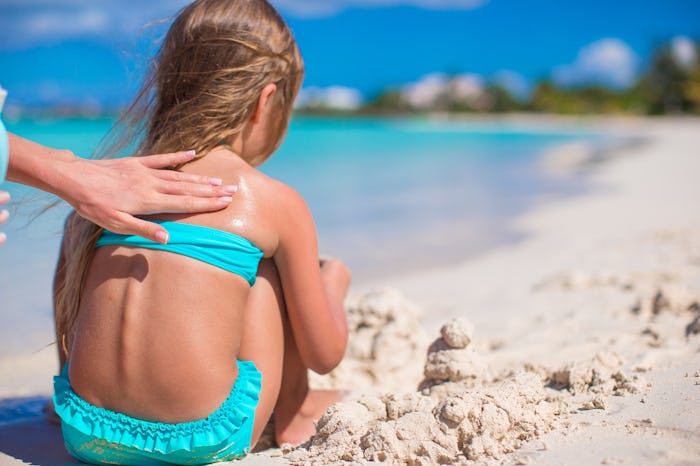Life

Here's How To Treat Your Kid's Sunburn, Because It's Bound To Happen This Summer
Just like playing outside in the winter means sniffles and sore throats, summer has its own recreational hazards: bug bites, poison ivy, and — perhaps worst of all — sunburns. Even parents who never leave the house without SPF 50, a wide-brimmed hat or two and a couple of rash guards will find themselves with a toasted tot at some point or another, because the sun is sneaky like that. If (ok, when) that happens, how should you treat your kid's sunburn so he can feel better fast? The last thing you want is for your little one's burn to keep him up all night.
One of the reasons why it's so easy for kids to get burned even when you're trying to be careful is that sometimes you can't even tell that they're burning until it's too late. The redness, pain, and swelling of a sunburn don't always start to show up until about four hours after being in the sun, according to Seattle Children's Hospital. (And don't be fooled by clouds: 70% of UV light still gets through on cloudy days.) Symptoms will peak at around 24 hours, and should start to subside after 48 hours. Two whole days is a long time for a kid to be uncomfortable, but on the bright side, most sunburns can be treated at home. There are exceptions, however: For a baby under one year old, sunburn should always be treated as an emergency, the Skin Cancer Foundation warns. Call your doctor right away. For kids one year or older, consult your pediatrician if there is severe pain, blistering, lethargy, or a fever over 101 F.
Assuming your kid's burn is mild enough for you to handle on your own, the first thing you'll want to do is help your kid to feel cooler. That's why before anything else, you need to get them out of the sun and into the shade (or, better still, the air-conditioning).
"This sounds obvious, but it’s worth stating," Claire McCarthy, M.D., wrote on Harvard Medical School's Harvard Health blog.
"Staying out in the sun is likely to make things worse (and a sunburn may be a sign of too much time in the sun), which can put kids at risk of heat exhaustion or even heat stroke," Dr. McCarthy added.
Once you're out of the sun, a cool bath or shower can soothe sunburn (skip the soap, which can be drying), or even cool, damp towels placed on your child's forehead, back, or whatever other areas are most affected (just be sure to change the towels as they heat up).
Since sunburn is an inflammatory reaction of the skin, ibuprofen (an anti-inflammatory) can help to block this reaction, as Seattle Children's Hospital explained. Ibuprofen, an anti-inflammatory, will help to reduce redness and swelling — but it needs to be started early: "If you think your child got too much sun, start ibuprofen then. Give it three times per day for two days. Don't wait for redness."
Your kid should wash down that ibuprofen with lots and lots of water, too. Because burned skin isn't able to hold water in as well as healthy skin, sunburn often causes dehydration, according to The Johns Hopkins School of Medicine. Make a point of giving your child extra fluids for several days or even longer.
From a topical perspective, aloe vera gel can help to take away some of the sting, according to the American Academy of Dermatology. You can even use the gel straight out of the plant if you happen to have one handy. But stay away from any lotions with petroleum, benzocaine, or lidocaine (petroleum traps heat in the skin, while benzocaine and lidocaine can be irritating). Another option is an over-the-counter hydrocortisone cream, which helps to bring swelling down.
What should you do if your kid's burn starts to blister? Because blistered skin is at risk of becoming infected, it's wise to call your doctor about this one.
"If the skin is blistered, your child has a second-degree burn that needs more intensive care," Dr. William Sears told Parenting.
Your pediatrician might prescribe an antibiotic cream to apply several times a day. Whatever you do, don't break the blisters (they prevent bacteria from getting into your kid's body), and when they pop on their own, keep them covered (your doctor might recommend using antibacterial cream and non-sticky gauze).
And, yet again, remember that an ounce of prevention is worth a pound of cure... so even though you're already trying to be sun safe, it can't hurt to be even more cautious next time.